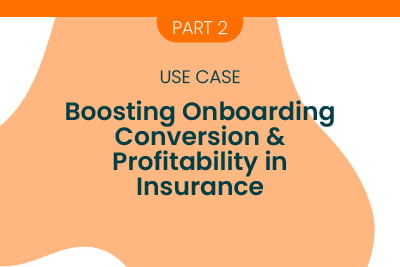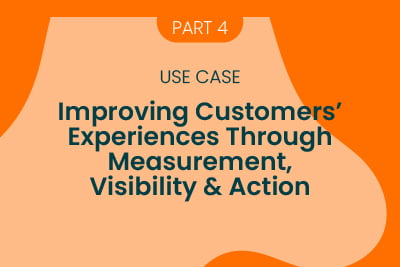
What’s the key to winning the future in insurance?
For insurers, it’s customer convenience. Policy holders everywhere want easy, fast, and on-demand – and they want it their way. Unfortunately, the reality is that many policy holders experience frustration when they file a claim – a time when they may already be annoyed or distraught, and a painful and lengthy claims process only makes matters worse! It’s been shown that many customers will switch insurers after submitting a claim, regardless of whether payment is made, simply because the experience is terrible. But what’s the possible result of a poor claims process?
Up to $170 billion of insurance premiums could be at risk in the next five years due to poor claims experiences, according to a recent report from Accenture*. Dissatisfaction around the claims experience is a key reason driving customers to switch insurers. Nearly one-third (30%) of dissatisfied claimants said they had switched carriers in the past two years, and another 47% said they were considering doing so. Overall, the consumers who reported not being fully satisfied could represent up to $34 billion in premiums annually, or up to $170 billion over the next five years.
Convenience during the claims process is nuanced, though. It also must include ensuring confidence and the feeling of safety, especially for people that are alone and feel vulnerable.
At inQuba, we’ve seen that effective and clear communication throughout the life of a claim is a key element of quality claims handling. Customer Journey Management, and specifically journey orchestration, makes this achievable. This communication needs to include ensuring confidence and empathy. It happens that a policy holder could have to make ten calls to a representative in order to keep updated, and this number can be reduced to zero through digital methods that includes ‘what happens next, and when’. This empathy will improve experiences, build loyalty and significantly reduce customer churn.
Bringing parties together & supporting women during claims
 As an insurance professional, you know that it’s a low touch industry with brands and policy holders mainly interreacting around renewals and increases. Until there’s a claim! When customers are going through the claims process, it’s usually after some kind of accident or emergency. They have experienced loss and are anxious and fearful of the unknown. It’s at this point that you can turn a harrowing experience into one that is empathetic, eases a customer’s anxiety and allows them to feel safe in the knowledge that you are there to assist. This builds trust.
As an insurance professional, you know that it’s a low touch industry with brands and policy holders mainly interreacting around renewals and increases. Until there’s a claim! When customers are going through the claims process, it’s usually after some kind of accident or emergency. They have experienced loss and are anxious and fearful of the unknown. It’s at this point that you can turn a harrowing experience into one that is empathetic, eases a customer’s anxiety and allows them to feel safe in the knowledge that you are there to assist. This builds trust.
Our client, a pioneer in women-centric Property and Casualty (P&C) and life insurance policies that include car, home, buildings, business, and life cover, specialize by providing extra support where needed to help women feel safer on the road and at home, and also to make their lives easier.
It’s difficult to communicate as a single brand when there are so many parties involved. The insurer identified an opportunity to improve the claims experience significantly by managing the communication process between all parties. The solution would provide visibility into the claims process and remove the customers’ burden of constantly chasing somebody for updates. In addition, with insurance packages especially designed for women, our client wanted to convey that they were ensuring safety, enabling confidence in service providers, and displaying empathy for all policy holders.
The claims process, from ‘First Notice of Loss’ onwards, is administrative and intricate. It involves multiple parties from the policy holder to the insurer, and to the adjuster and the independent service provider who’s about to ring the bell.
How did we ensure that policy holders experienced superior service while also addressing their personal safety concerns?
Scaling empathy & improving retention
1/ The actual claims journey
Rather than a conceptual customer journey map, existing data was used to visualize the actual claims journey. One of the noticeable aspects was the volume of calls made to service representatives during the claims process. Policy holders appeared to be needing to follow up or chase updates during the claim. More information was needed to understand the why.
2/ Measuring value delivery
Dipstick surveys were launched at different steps of the claims process to determine where value was being delivered (or not) as well as the policy holders’ sentiment. These steps included major status updates such as ‘pay’ or ‘no pay’, potentially long delays on parts sourcing, after the adjustment process, and then an overarching survey at the end of the claim. This revealed interesting insights:
- Customers didn’t feel like they were kept updated on status or next steps
- There was communication confusion due to updates from both insurer and service providers
- Customers needed a way of accessing support at any stage
- Some customers felt unsafe letting service providers into their homes
The feedback and sentiment could then be mapped to the obvious customer journeys, providing rich journey analytics. The information gathered would then be applied to the design of interventions and engagements that policy holders needed.

3/ Scaling empathy through journey orchestration
The engagement solution allowed for the management and visibility of communications between the insurer, the adjuster, the repairer, and the policy holder in one place, via personalized chat dialogues (in this case, WhatsApp). Chat solutions are immediate and personal and provide instant updates so that everyone is informed at all times and progress can be monitored.
When sending a repairer to a single mother’s home to repair a water leak, for example, how do you make sure she feels safe? The designed solution provided the policy holder with the name of the repairer, as well as the company name and logo so that she can check these details before allowing entry to her home. She’d be informed that the repairer is scheduled to arrive at 2.00pm, for example, and at 2.05pm she’d receive a check-in message to confirm that the repairer has arrived and that everything is OK. Should the repairer not have arrived, a solution will be found. Within 30 minutes, she will receive another message to check whether the repairer is still onsite and that everything is OK. Once the insurer receives notification from the repairer that the work is complete, the policy holder receives another message to check that she is satisfied with the work, and safe.
 The policy holder can signal for assistance through a chat app at any stage of the claim. Access to the facility alone creates comfort.
The policy holder can signal for assistance through a chat app at any stage of the claim. Access to the facility alone creates comfort.
In the idle time between updates, policyholders received messages to let them know that nothing had changed yet, but that the claim was in process. The dialogue included the adjustor appointment and repairer appointment, claims status updates, claim payment updates, and a closure message with a survey to determine the customer experience.
This level of journey orchestration highlights our client’s level of commitment and service delivery to the policy holder. The result is a massively enhanced claims experience which can be expanded to all customers across a variety of segments. Engagement strategies are finetuned over time, while paying close attention to the experience metrics.
Answering questions before they are asked
As an insurance professional, you will know that there are three moments when policy holder churn happens.
- At annual renewal and increase time
- When a claim is not paid
- When a claim is paid but the experience has been poor
Submitting a claim is a high-touch experience for the policy holder who will typically call a service representative multiple times to follow-up on progress. This is how customer experience begins negatively and generally continues downhill, influencing the entire claims journey.
By being proactive and automatically issuing a notification at each step of the claims process and informing the customer about their claim status we can eliminate the need for them to call.
As an insurer you have to delicately balance the efficient processing of claims while also delivering an experience worthy of your customer. This kind of care ranks very high when it comes to customer retention and future business.
Customers whose claims experience exceeds their expectations are more likely to stay with their current insurance company even when taking product pricing into consideration. Using Customer Journey Management to open lines of communication between your brand and your customers, thereby creating a personalized customer experience while ensuring empathy and support, will help your customers reach their goals, and you reach yours.
Main moments when policy holder churn take place
- At annual renewal and increase time
- When a claim is not paid
- When a claim is paid but the experience has been poor
Use case coming up!
Look out for our fourth post in the series where we’ll be looking at how a leading insurer set about improving the Claims and Servicing experiences by creating visibility and inspiring action.
We would love to understand your business challenges and the problems you’re trying to solve. Reach out to us and we’ll set you up with an expert for a no-obligation discussion.

Guide customer behavior with inQuba Journey Management
Download our product paper now
Read the full 4-part Insurance series now.
References:








